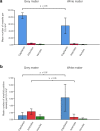Demonstrating a reduced capacity for removal of fluid from cerebral white matter and hypoxia in areas of white matter hyperintensity associated with age and dementia
- PMID: 32771063
- PMCID: PMC7414710
- DOI: 10.1186/s40478-020-01009-1
Demonstrating a reduced capacity for removal of fluid from cerebral white matter and hypoxia in areas of white matter hyperintensity associated with age and dementia
Abstract
White matter hyperintensities (WMH) occur in association with dementia but the aetiology is unclear. Here we test the hypothesis that there is a combination of impaired elimination of interstitial fluid from the white matter together with a degree of hypoxia in WMH. One of the mechanisms for the elimination of amyloid-β (Aβ) from the brain is along the basement membranes in the walls of capillaries and arteries (Intramural Peri-Arterial Drainage - IPAD). We compared the dynamics of IPAD in the grey matter of the hippocampus and in the white matter of the corpus callosum in 10 week old C57/B16 mice by injecting soluble Aβ as a tracer. The dynamics of IPAD in the white matter were significantly slower compared with the grey matter and this was associated with a lower density of capillaries in the white matter. Exposing cultures of smooth muscle cells to hypercapnia as a model of cerebral hypoperfusion resulted in a reduction in fibronectin and an increase in laminin in the extracellular matrix. Similar changes were detected in the white matter in human WMH suggesting that hypercapnia/hypoxia may play a role in WMH. Employing therapies to enhance both IPAD and blood flow in the white matter may reduce WMH in patients with dementia.
Keywords: Fibronectin; Intramural periarterial drainage; Laminin; White matter hyperintensities.
Conflict of interest statement
The authors declare no competing interests.
Figures








Similar articles
-
Convective influx/glymphatic system: tracers injected into the CSF enter and leave the brain along separate periarterial basement membrane pathways.Acta Neuropathol. 2018 Jul;136(1):139-152. doi: 10.1007/s00401-018-1862-7. Epub 2018 May 12. Acta Neuropathol. 2018. PMID: 29754206 Free PMC article.
-
White matter changes in dementia: role of impaired drainage of interstitial fluid.Brain Pathol. 2015 Jan;25(1):63-78. doi: 10.1111/bpa.12218. Brain Pathol. 2015. PMID: 25521178 Free PMC article. Review.
-
Proportions of Basement Membrane Proteins in Cerebrovascular Smooth Muscle Cells After Exposure to Hypercapnia and Amyloid Beta.Cells. 2025 Apr 18;14(8):614. doi: 10.3390/cells14080614. Cells. 2025. PMID: 40277938 Free PMC article.
-
The Pattern of AQP4 Expression in the Ageing Human Brain and in Cerebral Amyloid Angiopathy.Int J Mol Sci. 2020 Feb 12;21(4):1225. doi: 10.3390/ijms21041225. Int J Mol Sci. 2020. PMID: 32059400 Free PMC article.
-
White matter hyperintensities and geriatric syndrome: An important role of arterial stiffness.Geriatr Gerontol Int. 2015 Dec;15 Suppl 1:17-25. doi: 10.1111/ggi.12673. Geriatr Gerontol Int. 2015. PMID: 26671153 Review.
Cited by
-
Q-VAT: Quantitative Vascular Analysis Tool.Front Cardiovasc Med. 2023 Jun 2;10:1147462. doi: 10.3389/fcvm.2023.1147462. eCollection 2023. Front Cardiovasc Med. 2023. PMID: 37332588 Free PMC article.
-
Cerebral Vessels: An Overview of Anatomy, Physiology, and Role in the Drainage of Fluids and Solutes.Front Neurol. 2021 Jan 13;11:611485. doi: 10.3389/fneur.2020.611485. eCollection 2020. Front Neurol. 2021. PMID: 33519691 Free PMC article. Review.
-
Need for a Paradigm Shift in the Treatment of Ischemic Stroke: The Blood-Brain Barrier.Int J Mol Sci. 2022 Aug 22;23(16):9486. doi: 10.3390/ijms23169486. Int J Mol Sci. 2022. PMID: 36012745 Free PMC article. Review.
-
More severe initial manifestations and worse short-term functional outcome of intracerebral hemorrhage in the plateau than in the plain.J Cereb Blood Flow Metab. 2024 Jan;44(1):94-104. doi: 10.1177/0271678X231201088. Epub 2023 Sep 14. J Cereb Blood Flow Metab. 2024. PMID: 37708253 Free PMC article.
-
Measuring glymphatic function: Assessing the toolkit.Neural Regen Res. 2026 Feb 1;21(2):534-541. doi: 10.4103/NRR.NRR-D-24-01013. Epub 2025 Mar 25. Neural Regen Res. 2026. PMID: 40145955 Free PMC article.
References
-
- Szentistvanyi I, Patlak CS, Ellis RA, Cserr HF. Drainage of interstitial fluid from different regions of rat brain. AmJ Physiol. 1984;246(6 Pt 2):F835–FF44. - PubMed
Publication types
MeSH terms
Substances
Grants and funding
LinkOut - more resources
Full Text Sources
Medical

